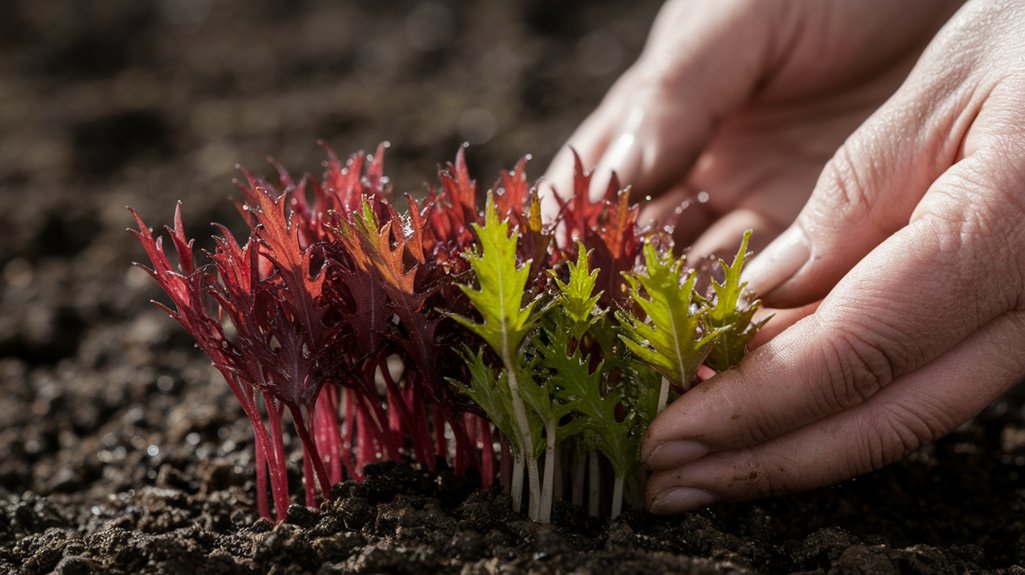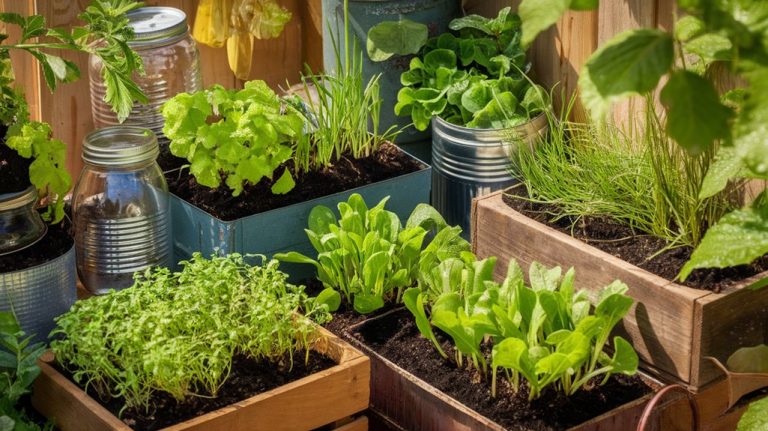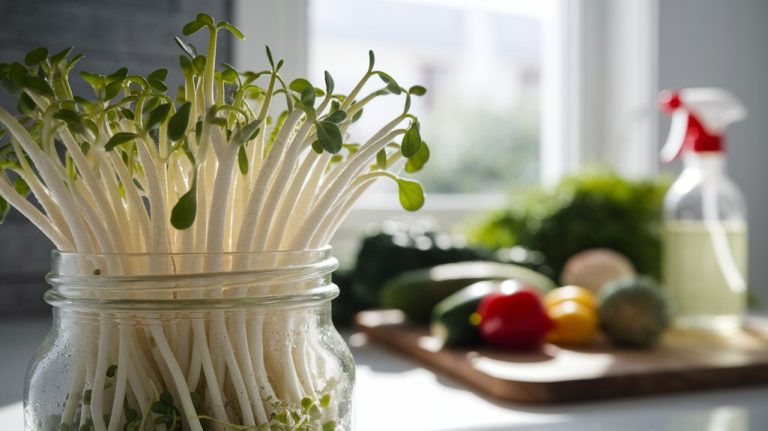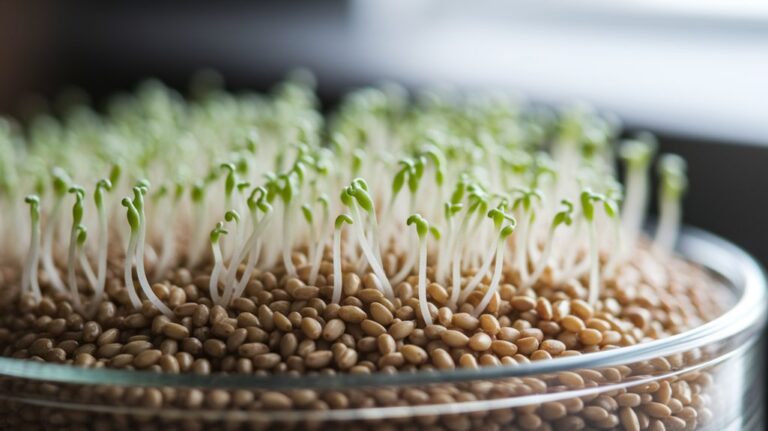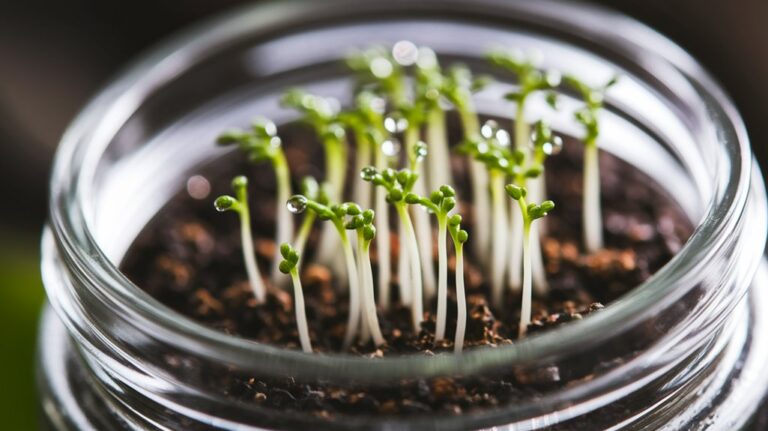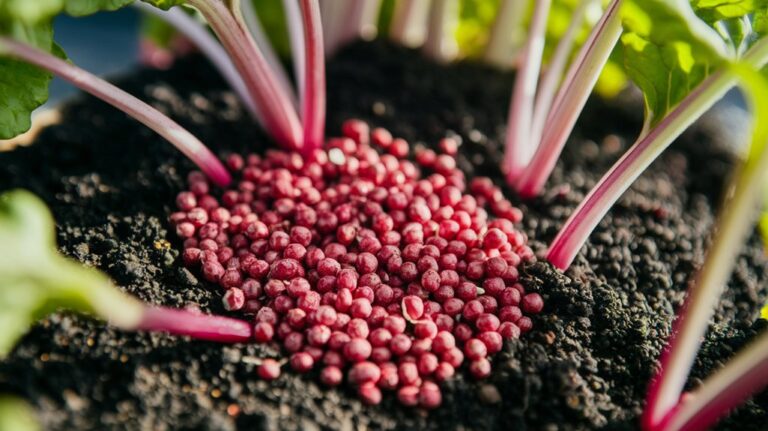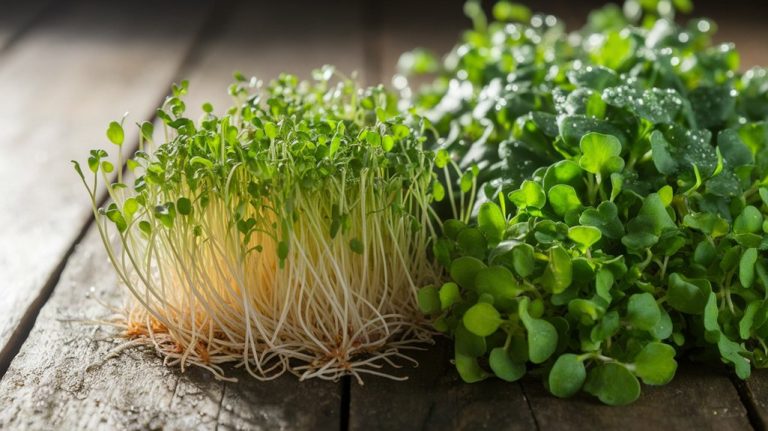How to Sprout Red Shiso (Perilla)
To sprout red shiso (Perilla), start by soaking high-quality seeds in water for 6-8 hours. Next, fill a 4-6 inch container with well-draining potting mix and scatter the seeds on top, lightly pressing them in. Cover the container with plastic wrap to maintain humidity and keep the soil damp. Place it in bright, indirect sunlight. Ensure consistent moisture as the seeds germinate. With proper care, you’ll have vibrant shiso plants thriving in no time. Discover more about nurturing these plants and their culinary uses.
Key Takeaways
- Soak red shiso seeds in water for 6-8 hours to enhance germination before planting.
- Use a well-draining potting mix and fill a 4-6 inch container for optimal growth.
- Scatter soaked seeds on the soil surface, pressing them in lightly, and cover with plastic wrap.
- Keep the soil consistently damp and place the container in bright, indirect sunlight for at least six hours daily.
- Thin seedlings to six inches apart and water regularly, avoiding waterlogging to prevent root rot.
Understanding Red Shiso and Its Benefits
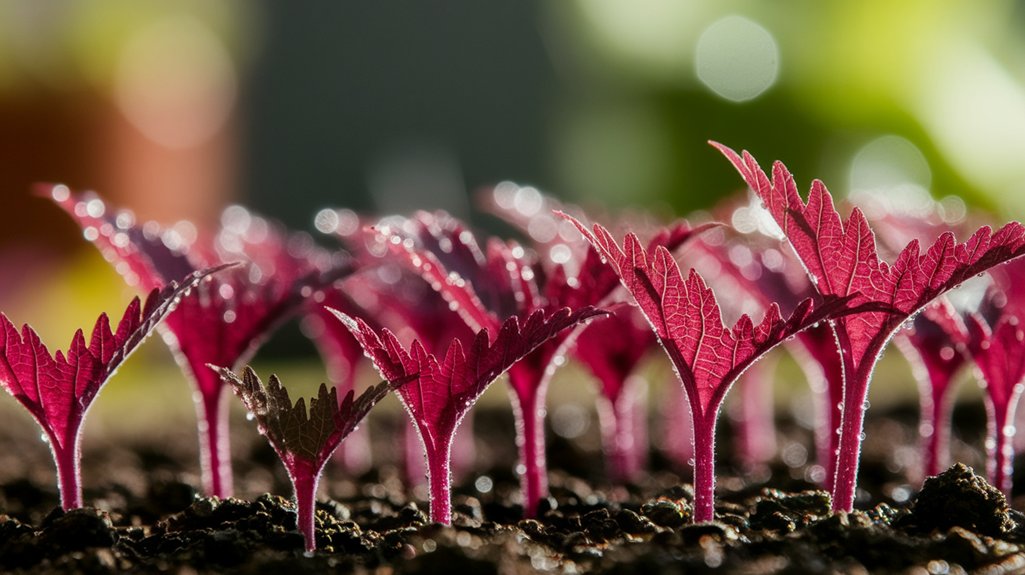
Red shiso, a vibrant herb belonging to the mint family, captures my interest not only for its striking color but also for its myriad benefits.
This herb, known scientifically as Perilla frutescens, boasts a unique flavor profile that’s both aromatic and slightly spicy, enhancing culinary dishes. Nutritionally, red shiso is rich in vitamins A and C, and it contains essential minerals like calcium and iron.
Additionally, its antioxidant properties may help combat oxidative stress, promoting overall health. I find it fascinating that red shiso has anti-inflammatory effects, potentially aiding in digestion and respiratory issues.
With its versatility and health benefits, incorporating red shiso into my garden or diet feels like a rewarding choice for both flavor and wellness.
Choosing the Right Seeds and Supplies
When selecting the right seeds for sprouting red shiso, it’s important to consider a few key factors to ensure successful growth. First, I recommend choosing high-quality seeds from a reputable source, ideally organic. Look for seeds that are fresh and have a good germination rate. Additionally, think about the supplies you’ll need, such as soil, containers, and a light source.
Here’s a quick reference table to help you:
| Factor | Recommendation | Notes |
|---|---|---|
| Seed Quality | Organic, fresh seeds | Check germination rates |
| Soil Type | Well-draining potting mix | Avoid heavy or compact soil |
| Container Size | 4-6 inch pots | Ensure good drainage |
Step-by-Step Guide to Sprouting Red Shiso
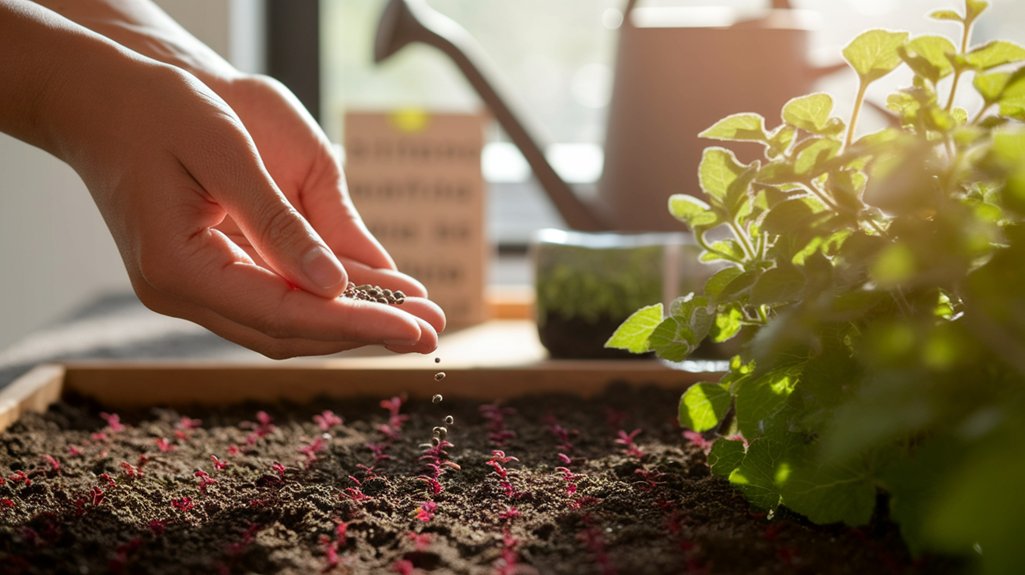
To successfully sprout red shiso, I’ll walk you through a straightforward, step-by-step process that covers everything from preparation to germination.
Follow these key steps for optimal results:
- Seed Soaking: Start by soaking your red shiso seeds in water for 6-8 hours. This softens the seed coat and enhances germination.
- Prepare the Soil: Use a well-draining potting mix or seed-starting soil. Fill your container, ensuring it’s moistened but not soggy.
- Sow the Seeds: Scatter the soaked seeds evenly across the surface of the soil. Lightly press them in, but don’t cover them too deeply.
- Maintain Moisture: Cover the container with plastic wrap or a humidity dome until germination occurs, keeping the soil consistently damp.
Following these steps will lead to successful sprouting!
Caring for Your Sprouted Red Shiso
After your red shiso seeds have successfully sprouted, it’s important to provide the right care to ensure healthy growth.
Start by placing your seedlings in a location that receives bright, indirect sunlight for at least six hours daily. I water them regularly, keeping the soil consistently moist but not soggy; overwatering can lead to root rot.
Once the seedlings reach about four inches, I thin them out, leaving the strongest plants spaced about six inches apart to promote airflow. I also fertilize them every two weeks with a balanced liquid fertilizer, following the package instructions.
Monitoring for pests and diseases is crucial; I inspect the leaves regularly and act promptly if I notice any issues.
Culinary Uses and Storage Tips for Red Shiso
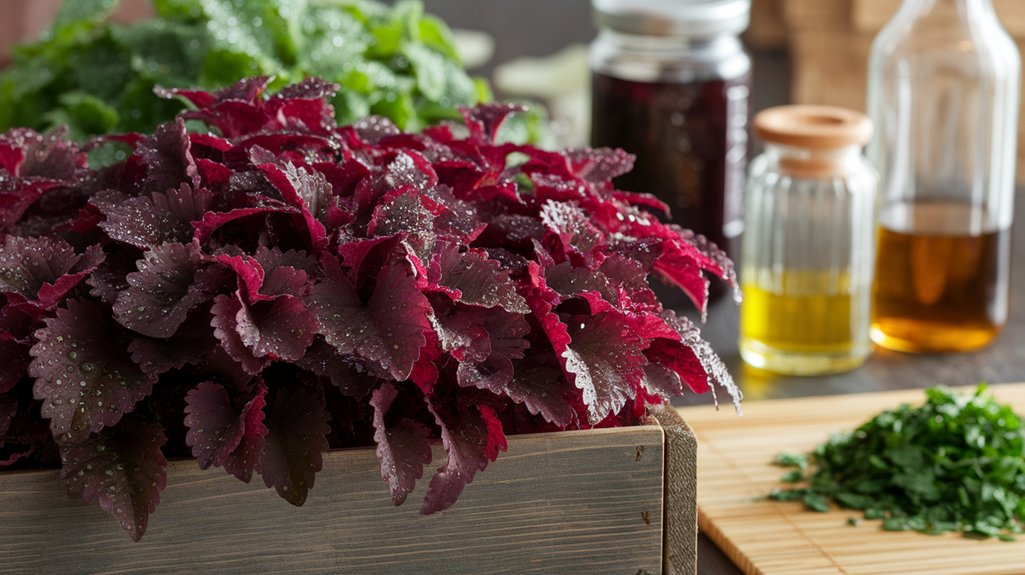
Although red shiso is often overshadowed by more common herbs, I find its unique flavor and vibrant color make it a valuable addition to various dishes.
I love incorporating it into my cooking for its aromatic qualities and nutritional benefits. Here are some culinary uses and storage tips for red shiso:
- Garnish: Use fresh leaves to enhance sushi, sashimi, or salads for a pop of color and flavor.
- Infusion: Steep leaves in hot water to create a fragrant herbal tea.
- Condiment: Blend with sesame oil and soy sauce for a flavorful dressing or marinade.
- Storage: Keep fresh shiso in a damp paper towel inside a plastic bag in the fridge to maintain its freshness for up to a week.
Frequently Asked Questions
Can I Grow Red Shiso Indoors Year-Round?
Absolutely, you can grow red shiso indoors year-round!
I’ve found that it thrives in well-drained soil and requires bright, indirect sunlight.
Make sure to maintain a temperature between 65°F and 75°F for optimal growth.
I water the plants when the top inch of soil feels dry, ensuring not to overwater.
Using a grow light can really help during darker months.
With the right conditions, you’ll enjoy fresh red shiso all year long!
How Long Does Red Shiso Take to Mature?
Red shiso typically takes about 70 to 90 days to mature after germination.
I’ve found that providing consistent moisture and good sunlight helps speed up the growth process.
When I grow it, I make sure to keep the soil well-drained and enriched with nutrients.
Once the leaves reach a vibrant color and a decent size, I know they’re ready for harvest.
It’s a rewarding experience to watch them thrive!
Is Red Shiso Safe for Pets?
I’ve researched whether red shiso is safe for pets, and the good news is that it’s generally considered non-toxic to cats and dogs.
However, I’ve found that some pets might’ve sensitivities or allergies.
It’s always wise to monitor your pet if you introduce new plants into their environment.
If you notice any unusual behavior after they’ve been around red shiso, consult your veterinarian for advice.
Better safe than sorry!
Can I Use Red Shiso Seeds From My Garden?
Absolutely, you can use red shiso seeds from your garden!
I’ve done it myself, and they’re typically viable if they’ve been stored properly and are fresh.
Make sure to clean them and check for any signs of damage or mold.
Plant them in well-draining soil, and ensure they receive adequate sunlight.
I’ve seen great results when I give them the right conditions, so don’t hesitate to give it a go!
What Pests Should I Watch Out for With Red Shiso?
When growing red shiso, I always watch out for pests like aphids, spider mites, and whiteflies.
These critters can sap the plant’s strength and affect its flavor. I’ve found that regularly inspecting the leaves helps catch infestations early.
If I spot any pests, I act quickly with insecticidal soap or neem oil. Keeping the plants healthy and well-watered also reduces the chances of pest problems, so I make that a priority.
Conclusion
In conclusion, sprouting red shiso is a rewarding endeavor that not only enriches your garden but also enhances your culinary creations. With the right seeds and proper care, you can enjoy the vibrant flavor and numerous health benefits this herb offers. By following the outlined steps and tips, you’ll be well-equipped to cultivate your own red shiso and incorporate it into various dishes. Embrace this journey, and let the unique taste of red shiso elevate your meals!

